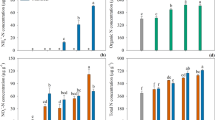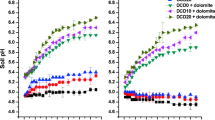Summary
The kinetics of dicyandiamide (DCD) decomposition were studied (at 80% water-holding capacity) in pretreated and non-pretreated soils, using model experiments. DCD was added in different concentrations (6.7, 16.7, and 33.3 μg DCD-N g−1 dry soil) and incubated at various temperatures (10°, 20°, and 30°C). Additionally, DCD decomposition was examined in sterile soil (with or without Fe2O3) after inoculation with a DCD-enrichment culture. In the sterile variant, (30°C)the applied dicyandiamide concentration remained constant, even after 36 days. In the sterilized and reinoculated variant, DCD disappeared within 7 days. Addition of Fe2O3 powder to the sterilized soil had no effect on DCD degradation. In the pretreated soils, DCD mineralization started immediately at all temperatures and concentrations without a lag phase. A temperature increase of 10°C doubled the mineralization rate. The mineralization rates were independent of the initial concentrations. In the non-pretreated soils (except at 30°C with 16.7 and 33.3 μg DCD-N g−1 dry soil) DCD decreased only after a short (30°C) or a long (10°C) lag phase. These results suggest that an inducible metabolic degradation occurred, following zeroorder kinetics.
Similar content being viewed by others
References
Amberger A (1983) Wirkung und Einsatzmöglichkeiten des Nitrifikationshemmstoffes Dicyandiamid. Symposium Nitrifikationshemmstoffe, Verband Deutscher Landwirtschaftlicher Untersuchungs- und Forschungsanstalten — Schriftenreihe, Heft 11:22–47
Amberger A (1986) Potentials of nitrification inhibitors in modern N-fertilizer management. Z. Pflanzenernaehr Bodenkd 149:469–484
Amberger A, Vilsmeier K (1979) Dicyandiamidabbau in Quarzsand und Böden. Z. Pflanzenernaehr Bodenkd 142:778–785
Battersby NS (1990) A review of biodegradation kinetics in the aquatic environment. Chemosphere 21:1243–1284
Benckiser G, Warneke-Busch G (1990) Denitrifikation mineralisch und/oder klärschlammgedüngter Agrarökosysteme in Abhängigkeit von Kohlenstoff-,Wasser- und Nitratversogrgung sowie der Bodentemperatur. Forum Städte-Hygiene 41:157–160
Grover R (1967) Studies on the degradation of 4-amino-3,5,6-tri-chlorpicolinic acid in soil. Weed Res 7:61–67
Guiraud G, Marol C, Thibaud MC (1989) Mineralization of nitrogen in the presence of a nitrification inhibitor. Soil Biol Biochem 21:29–34
Hallinger S, Wallnöfer PR, Goldbach H, Amberger A (1990) Several aspects of bacterial dicyandiamide degradation. Naturwissenschaften 77:332–334
Hance RJ, McKone CE (1971) Effect of concentration on the decomposition rates in soil of atrazine, linuron and picloram. Pestic Sci 2:31–34
Hauck R (1983) Nitrification inhibitors — potentials and limitations. Symposium Nitrifikationshemmstoffe,Verband Deutscher Landwirtschaftlicher Untersuchungs- und Forschungsanstalten — Schriftenreihe, Heft 11:9–21
Hauser M, Haselwandter K (1990) Degradation of dicyandiamide by soil bacteria. Soil Biol Biochem 22:113–114
Kapp M, Schwarz J, Benckiser G, Ottow JCG (1990) Der Einsatz der Acetylen-Inhibierungstechnik zur Quantifizierung von Denitrifikationsverlusten in unterschiedlich gedüngten Weidelgrasbeständen. Forum Städte-Hygiene 41:168–172
Rodgers GA (1986) Potency of nitrification inhibitors following their repeated application to soil. Biol Fertil Soils 2:105–108
Sahrawat KL, Keeney DR (1985) Perspectives for research on development of nitrification inhibitors. Commun Soil Sci Plant Anal 16:517–524
Sahrawat KL, Keeney DR, Adams SS (1987) Ability of nitrapyrin, dicyandiamide and acetylen to retard nitrification in a mineral and an organic soil. Plant and Soil 101:179–182
Schwarz J, Kapp M, Benckiser G, Ottow JCG (1990) Einfluss des Nitrifikationshinhibitors Dicyandiamid (DCD) auf Nitratverfügbarkeit, aktuelle und potentielle Nitrifikationsraten sowie Denitrifikationsverluste einer Weidelgrasmonokultur nach Gülledüngung. Verband Deutscher Landwirtschaftlicher Untersuchungs- und Forschungsanstalten — Schriftenreihe, Heft 32:659–664
Stanford G, Frere MH, Schwaninger DH (1973) Temperature coefficient of soil nitrogen mineralization. Soil Sci 115:321–323
Vilsmeier K (1979) Kolorimetrische Bestimmung von Dicyandiamid in Böden. Z Pflanzenernaehr. Bodenkd 142:792–798
Von Bischopinck KU, Ottow JCG (1985) Einfluss der Temperature auf Kinetik und Gaszusammensetzung der Denitrifikation in sandigem Lehm. Mitt Dtsch Bodenkd Ges 43:537–542
Author information
Authors and Affiliations
Rights and permissions
About this article
Cite this article
Rajbanshi, S.S., Benckiser, G. & Ottow, J.C.G. Effects of concentration, incubation temperature, and repeated applications on degradation kinetics of dicyandiamide (DCD) in model experiments with a silt loam soil. Biol Fertil Soils 13, 61–64 (1992). https://doi.org/10.1007/BF00337336
Received:
Issue Date:
DOI: https://doi.org/10.1007/BF00337336




